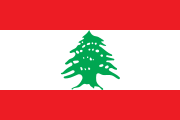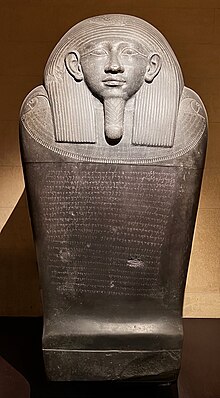The Lebanon PortalA view of Byblos, Lebanon
 Lebanon (/ˈlɛbənɒn, -nən/ LEB-ə-non, -nən; Arabic: لُبْنَان, romanized: Lubnān, local pronunciation: [lɪbˈneːn]), officially the Republic of Lebanon, is a country in the Levant region of West Asia. It is bordered by Syria to the north and east, by Israel to the south, and by the Mediterranean Sea to the west; Cyprus lies a short distance away from the country's coastline. Lebanon's location at the crossroads of the Mediterranean Basin and the Arabian hinterlands has contributed to the country's rich history and shaped a unique cultural identity shaped by religious diversity. Lebanon has a population of more than five million people and covers an area of 10,452 square kilometres (4,036 sq mi). Lebanon's capital and largest city is Beirut, followed by Tripoli and Jounieh. While Arabic is the official language, French is also recognized in a formal capacity; Lebanese Arabic is the country's vernacular, though French and English play a relatively significant role in everyday life, with Modern Standard Arabic being limited to news and government matters. The earliest evidence of human civilization in Lebanon dates back to 5000 BCE. From 3200 to 539 BC, what was to become Lebanon was part of Phoenicia, a maritime empire that stretched the Mediterranean Basin. In 64 BC, the Roman Empire conquered the region, and Lebanon soon became a major center for Christianity under the aegis of the Byzantine Empire. In the 7th century, the Muslim conquest of the Levant brought the region under the control of the Rashidun Caliphate. The 11th century saw the beginning of the Crusades and the establishment of Crusader states, which later fell to the Ayyubids and the Mamluks, who in turn ceded the territory to the Ottoman Turks in the aftermath of the Ottoman–Mamluk War of 1516–1517. Under Ottoman ruler Abdulmejid I, the first Lebanese proto-state was established in the form of the Mount Lebanon Mutasarrifate, created in the 19th century as a home for Maronite Christians under the Ottoman "Tanzimat" period. Lebanon is a developing country, ranked 112th on the Human Development Index. It has been classified as an upper-middle-income state. The Lebanese liquidity crisis, coupled with nationwide corruption and recent disasters such as the 2020 Beirut explosion, have precipitated the collapse of Lebanon's currency and fomented political instability, widespread resource shortages, and high unemployment and poverty. The World Bank has defined Lebanon's economic crisis as one of the world's worst since the 19th century. Despite the country's small size, Lebanese culture is renowned both in the Arab world and globally, powered primarily by the Lebanese diaspora. Lebanon is a founding member of the United Nations and of the Arab League, and is a member of the Non-Aligned Movement, the Organization of Islamic Cooperation, the Organisation internationale de la Francophonie, and the Group of 77, among others. (Full article...) This is a Featured article, one of the best articles Wikipedia has to offer.
Levantine Arabic, also called Shami (autonym: شامي šāmi or اللهجة الشامية el-lahje š-šāmiyye), is an Arabic variety spoken in the Levant, namely in Syria, Jordan, Lebanon, Palestine, Israel and southern Turkey (historically only in Adana, Mersin and Hatay provinces). With over 54 million speakers, Levantine is, alongside Egyptian, one of the two prestige varieties of spoken Arabic comprehensible all over the Arab world. Levantine is not officially recognized in any state or territory. Although it is the majority language in Jordan, Lebanon, Palestine, and Syria, it is predominantly used as a spoken vernacular in daily communication, whereas most written and official documents and media in these countries use the official Modern Standard Arabic (MSA), a form of literary Arabic only acquired through formal education that does not function as a native language. In Israel and Turkey, Levantine is a minority language. The Palestinian dialect is the closest vernacular Arabic variety to MSA, with about 50% of common words. Nevertheless, Levantine and MSA are not mutually intelligible. Levantine speakers therefore often call their language العامية al-ʿāmmiyya , 'slang', 'dialect', or 'colloquial'. However, with the emergence of social media, attitudes toward Levantine have improved. The amount of written Levantine has significantly increased, especially online, where Levantine is written using Arabic, Latin, or Hebrew characters. Levantine pronunciation varies greatly along social, ethnic, and geographical lines. Its grammar is similar to that shared by most vernacular varieties of Arabic. Its lexicon is overwhelmingly Arabic, with a significant Aramaic influence. (Full article...)Did you know (auto-generated) -
TopicsRelated portalsReligions in Lebanon Arab states Other countries This is a Good article, an article that meets a core set of editorial standards.
The sarcophagus of Eshmunazar II is a 6th-century BC sarcophagus unearthed in 1855 in the grounds of an ancient necropolis southeast of the city of Sidon, in modern-day Lebanon, that contained the body of Eshmunazar II (Phoenician: 𐤀𐤔𐤌𐤍𐤏𐤆𐤓 ʾšmnʿzr, r. c. 539 – c. 525 BC), Phoenician King of Sidon. One of only three Ancient Egyptian sarcophagi found outside Egypt, with the other two belonging to Eshmunazar's father King Tabnit and to a woman, possibly Eshmunazar's mother Queen Amoashtart, it was likely carved in Egypt from local amphibolite, and captured as booty by the Sidonians during their participation in Cambyses II's conquest of Egypt in 525 BC. The sarcophagus has two sets of Phoenician inscriptions, one on its lid and a partial copy of it on the sarcophagus trough, around the curvature of the head. The lid inscription was of great significance upon its discovery as it was the first Phoenician language inscription to be discovered in Phoenicia proper and the most detailed Phoenician text ever found anywhere up to that point, and is today the second longest extant Phoenician inscription, after the Karatepe bilingual. The sarcophagus was discovered by Alphonse Durighello, a diplomatic agent in Sidon engaged by Aimé Péretié, the chancellor of the French consulate in Beirut. The sarcophagus was sold to Honoré de Luynes, a wealthy French nobleman and scholar, and was subsequently removed to the Louvre after the resolution of a legal dispute over its ownership. More than a dozen scholars across Europe and the United States rushed to translate the sarcophagus inscriptions after its discovery, many noting the similarities between the Phoenician language and Hebrew. The translation allowed scholars to identify the king buried inside, his lineage, and his construction feats. The inscriptions warn against disturbing Eshmunazar II's place of repose; it also recounts that the "Lord of Kings", the Achaemenid king, granted Eshmunazar II the territories of Dor, Joppa, and Dagon in recognition for his services. (Full article...)General imagesThe following are images from various Lebanon-related articles on Wikipedia.
CategoriesAssociated WikimediaThe following Wikimedia Foundation sister projects provide more on this subject:
SourcesDiscover Wikipedia using portals |
How Can We Help?



























































Recent Comments